|
|
|
Sort Order |
|
|
|
Items / Page
|
|
|
|
|
|
|
| Srl | Item |
| 1 |
ID:
172195
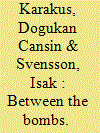

|
|
|
|
|
| Summary/Abstract |
Previous research on ceasefires in armed conflicts has primarily focused on the aggregated country-level of analysis. By contrast, this article contributes by examining the local-level dynamics of local ceasefire arrangements. In particular, this study examines a novel set of 106 local-level ceasefire arrangements in the Syrian Civil War, reached between the years 2011 to 2017. Most (72 percent), but not all, of the ceasefire arrangements were respected during the stipulated time period. We argue that informal and domestic peacemaking should outperform formal and external approaches in managing conflicts with multiple rebel groups, ongoing violence, and different fronts such as in Syria. We find that the presence of insider mediators (“insider-partial”) as well as confidence-building measures between the belligerents are positively associated with successful ceasefire arrangements, whereas explanations emphasized by previous research—external third-party mediation as well as various indicators of quality of agreement—fail to explain outcomes of ceasefires. Yet, we also find some evidence indicative of a selection effect in that external mediators are associated with more difficult conflict situations. The study of local ceasefires in the Syrian Civil War can stimulate further examinations of the micro-dynamics of peacemaking in civil wars, including the causes and consequences of local ceasefires.
|
|
|
|
|
|
|
|
|
|
|
|
|
|
|
|
| 2 |
ID:
085030
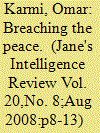

|
|
|
| 3 |
ID:
178370
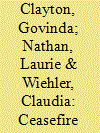

|
|
|
|
|
| Summary/Abstract |
The causes and consequences of ceasefires have become a burgeoning area of research. The concept of ceasefire success is integral to this research and plays a key role as either the dependent or independent variable in both qualitative and quantitative work. Despite its importance, it is not clear how ceasefire success should be conceptualized. This critically hampers the progress of theoretical and empirical research on ceasefires. This article offers a conceptual framework based on the central proposition that ceasefire success should be assessed in terms of two inter-related but conceptually distinct criteria: the immediate objective and the underlying purpose. The immediate objective, which is embedded in the definition of a ceasefire, is the cessation of hostilities (either permanently or temporarily). While all ceasefires share this objective, their underlying purpose, which is the reason for establishing the ceasefire, varies widely across cases. The immediate objective and the purpose, while conceptually distinct, are linked since the purpose informs the temporal and geographic scope of the cessation of hostilities. Based on this framework, we argue that researchers interested in ceasefire success need to clearly identify their assumptions and conceptual choices, which should take account of the political context of the ceasefires in question.
|
|
|
|
|
|
|
|
|
|
|
|
|
|
|
|
| 4 |
ID:
125928
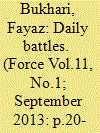

|
|
|
|
|
| Publication |
2013.
|
| Summary/Abstract |
After a decade of peace, the Line of Control (LC) in Poonch sector is hot again following the killing of five soldiers by Border Action Team (BAT) of Pakistan army at Khari Karmara village in Poonch sector on August 6. This was the second BAT action in Poonch sector this year. Earlier, two soldiers were beheaded early January. The intense LC firing started three days after the BAT action only after the army got a go ahead for a befitting reply to Pakistani ceasefire violations in the sector.
|
|
|
|
|
|
|
|
|
|
|
|
|
|
|
|
| 5 |
ID:
122260
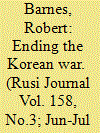

|
|
|
|
|
| Publication |
2013.
|
| Summary/Abstract |
Historical interpretations of the end of the Korean War traditionally emphasise the importance of the election of President Dwight D Eisenhower, the leadership change in the Soviet Union, and the PRC's desire to focus on modernisation compounded by the failure to achieve its war aims. Robert Barnes, however, argues that these explanations fail to take into account a key additional factor: the UN negotiations in late 1952 regarding the thorny issue of the post-war fate of prisoners of war. It was the eventual adoption of a resolution promoted by India and supported by the Commonwealth, and its final acceptance by both belligerent sides, that paved the way for a ceasefire.
|
|
|
|
|
|
|
|
|
|
|
|
|
|
|
|
| 6 |
ID:
126216
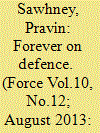

|
|
|
|
|
| Publication |
2013.
|
| Summary/Abstract |
It was a masterstroke by the Pakistan Army 10 years ago. The cue, probably, came from the blockbuster Bollywood movie, Baazigar (gambler), where the hero believed that to gain something big, you have to lose something. By offering the ceasefire on the Line of Control (LC) on 24 November 2003, the Pakistan Army gained a windfall in return for peanuts: it sacrificed covering fire to infiltration across the LC. In return, it got a tamed Indian Army which fenced itself on the LC sending the unambiguous signal that its offensive thinking of the Nineties had been put aside. Docility became the mind-set of the Indian Army and all that is wrong with this wonderful organisation today followed.
|
|
|
|
|
|
|
|
|
|
|
|
|
|
|
|
| 7 |
ID:
141037
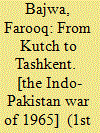

|
|
|
|
|
| Edition |
1st ed.
|
| Publication |
New Delhi, Pentagon Press, 2015.
|
| Description |
415p.hbk
|
| Standard Number |
9788182747647
|
|
|
|
|
|
|
|
|
|
|
|
Copies: C:1/I:0,R:0,Q:0
Circulation
| Accession# | Call# | Current Location | Status | Policy | Location |
| 058319 | 954.9045/BAJ 058319 | Main | On Shelf | General | |
|
|
|
|
| 8 |
ID:
050921
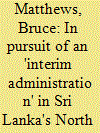

|
|
|
| 9 |
ID:
133686
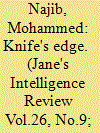

|
|
|
|
|
| Publication |
2014.
|
| Summary/Abstract |
Following the withdrawal of Israel's ground from the Gaza Strip, but with the violence continuing, relations between Hamas, the Palestinian Authority and Tel Aviv have reached a significant juncture. Mohammed Najib explores the dynamics.
|
|
|
|
|
|
|
|
|
|
|
|
|
|
|
|
| 10 |
ID:
124697
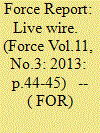

|
|
|
|
|
| Publication |
2013.
|
| Summary/Abstract |
After a long peace since the ceasefire came into being on 26 November 2003, the International Border (IB) in Jammu witnessed numerous ceasefire violations in 2013. Unlike the Line of Control (LC) which has seen innumerable ceasefire violations each year, with as many as 250 in 2013 alone, the IB getting live was unusual. The firings intensified since August causing loss of lives and property to civilians, who unlike the LC, live close to the IB. This unexpected activity got the Jammu and Kashmir chief minister, Omar Abdullah, to say that India should exercise options to silence Pakistani firing. Matters, however, finally settled on the IB with the recent meeting of the Border Security Force (BSF) and its counterpart, the Pakistani Chhamb rangers in R.S Pura sector. At sector commanders' level, both the sides agreed to maintain ceasefire and restore issues through negotiations.
|
|
|
|
|
|
|
|
|
|
|
|
|
|
|
|
| 11 |
ID:
132301
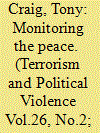

|
|
|
|
|
| Publication |
2014.
|
| Summary/Abstract |
During the Provisional IRA's (PIRA) 1975 ceasefire, two different sets of incident centres were established across Northern Ireland in order to monitor and avert escalation of violence between Republicans and Security Forces. While one group of offices was run by the Northern Ireland Office (NIO) and administered by clerks in the Northern Ireland Civil Service, very quickly Sinn Féin (taking advantage of their decriminalisation in 1974) established their own incident centres to coordinate their communication with the government. This article argues that the establishment of the Sinn Féin incident centres set a precedent for the future political activity of the Provisional Republican Movement; that their activity during the 1975 ceasefire played an important formative role in the evolution of the group's political strategy; and that this experience, acquired from the work done during the 1975 truce, was of far greater influence than is appreciated in current accounts.
|
|
|
|
|
|
|
|
|
|
|
|
|
|
|
|
| 12 |
ID:
130180
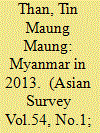

|
|
|
|
|
| Publication |
2014.
|
| Summary/Abstract |
The year 2013 in Myanmar saw parliaments disagreeing with the executive. A joint parliamentary committee to review and amend the Constitution was formed. Western sanctions were virtually withdrawn. A resurgence of communal violence, the emergence of Buddhist nationalism, and public protest over mega-projects, land rights, wage disputes, and freedom to demonstrate were worrisome developments. A nationwide ceasefire agreement remained elusive.
|
|
|
|
|
|
|
|
|
|
|
|
|
|
|
|
| 13 |
ID:
137914
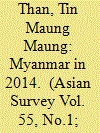

|
|
|
|
|
| Summary/Abstract |
Myanmar saw some progress in efforts at constitutional amendment and ceasefire negotiations, both pressing issues. Attempts to introduce proportional representation failed in the lower house of Parliament. Critics pointed out stalled reforms. The economy achieved high growth, and foreign direct investment increased. Myanmar reveled in its role as ASEAN chair and host for President Obama’s visit.
|
|
|
|
|
|
|
|
|
|
|
|
|
|
|
|
| 14 |
ID:
174814
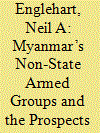

|
|
|
|
|
| Summary/Abstract |
Myanmar has suffered the world’s longest civil war, with continuous combat since shortly before the country’s independence from the UK in 1948. A new National Ceasefire Agreement has raised hopes that peace may finally be in sight. However, optimism should be tempered by a recognition the peace process has not built much trust, reduced the number of non-state armed groups in the country, their total size, or significantly improved their human rights behavior. This is demonstrated through an analysis of original data on the major non-state armed groups active in Myanmar between 1985 and 2017. Peace will require hard political work leading to disarmament, restraining the military, and reassuring the country’s ethnic minority groups that their rights and interests will be respected even without the threat of insurgent violence.
|
|
|
|
|
|
|
|
|
|
|
|
|
|
|
|
| 15 |
ID:
109195
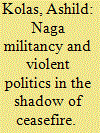

|
|
|
|
|
| Publication |
2011.
|
| Summary/Abstract |
Ceasefires are often seen as a simple measure to end violence and allow more substantive negotiations to begin. Contemporary conflict resolution models thus posit the ceasefire as a basic step in the peacebuilding trajectory. Offering an in-depth analysis of Naga militancy in Northeast India, this article argues that ceasefires should rather be understood as a part of the dynamics of conflict. Northeast India is a site of protracted conflict involving multiple contestants, where Naga militant organizations play a key role. A string of ceasefires since 1997 between the Indian government and the National Socialist Council of Nagalim (NSCN) has contained fighting between security forces and militants, while violence has continued unabated between NSCN factions and among an array of other armed groups in the area claimed as 'Nagalim', with serious consequences for local communities. This study suggests that ceasefires may impact on conflict dynamics in at least three ways, all interrelated: (1) by affecting the internal cohesion of belligerent groups, (2) by affecting the operational space of armed groups, and (3) by affecting the relations between multiple stakeholders and parties to a conflict, including but not limited to the challenger(s) and the state. The study concludes that the terms of ceasefire agreements, the strategic use of ceasefires by conflict actors, and the opportunities created by a lack of effective monitoring of ceasefire ground rules has facilitated the operations of militants vying for territory, revenues from illegal 'taxation' and political stakes. Ceasefires have also paved the way for an escalation of factional and intergroup fighting and violent politics in Northeast India, by empowering signatory groups versus contenders as well as nonviolent actors.
|
|
|
|
|
|
|
|
|
|
|
|
|
|
|
|
| 16 |
ID:
080606
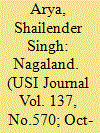

|
|
|
| 17 |
ID:
086330


|
|
|
|
|
| Publication |
2009.
|
| Summary/Abstract |
The tragic August conflict between Georgia and Russia has initiated a wave of accusations about which side was to blame for the outbreak of full-scale war. The war and its aftermath have ratcheted tensions between the West and Russia, as the international community pressures Moscow to withdraw its troops from Georgian territory and abide by its ceasefire obligations. Russia's reckless decision to recognize the independence of South Ossetia and Abkhazia not only contravenes international law regarding sovereign statehood, but if allowed to stand, would establish the unacceptable precedent that countries can justify military intervention in the territory of a neighbor by invoking the rights of their ethnic citizens. Not surprisingly, Moscow has found little support in the international community for its heavy-handed actions, even among countries friendly to Russia.
|
|
|
|
|
|
|
|
|
|
|
|
|
|
|
|
| 18 |
ID:
184179


|
|
|
|
|
| Summary/Abstract |
Based on conflict data, interviews and media monitoring, this study of Myanmar’s non-inclusive ceasefires develops a four-step argument about the effect of ceasefires in complex conflict systems. First, non-state armed groups rarely co-ordinate their actions strategically. This makes it easy for governments to obtain ceasefires with some groups while fighting others. Second, when ceasefires ensure armed groups’ survival, they mostly hold. Third, non-inclusive ceasefires do not reduce a country’s overall level of violence, since fighting tends to escalate with excluded groups. On this basis we conclude that non-inclusive ceasefires do not present a viable alternative to an inclusive peace process.
|
|
|
|
|
|
|
|
|
|
|
|
|
|
|
|
| 19 |
ID:
133685
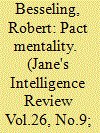

|
|
|
|
|
| Publication |
2014.
|
| Summary/Abstract |
Mozambique's governing and opposition parties are set to sign an agreement aimed at ending the RENAMO insurgency before the general election. Robert Besseling explores the effect the election results will have on the agreement's implementation.
|
|
|
|
|
|
|
|
|
|
|
|
|
|
|
|
| 20 |
ID:
193115
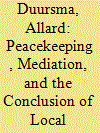

|
|
|
|
|
| Summary/Abstract |
This article theorizes on how military and civilian components of peacekeeping operations contribute to the conclusion of local ceasefires in non-state conflicts involving armed opposition groups or communal groups. A mediation-based logic suggests that civilian peacekeeping staff can provide technical support aimed at resolving the conflict issues and engage with state officials to promote peace. A capabilities-based logic suggest that military peacekeepers can provide security during the negotiations, arrange logistics, and put military pressure on the conflict parties, which all should make the conclusion of a ceasefire more likely. The analysis supports both the capabilities-based and the mediation-based logic. An instrumental variable estimation helps to account for endogeneity. This article contributes to the literature on peacekeeping, mediation, and ceasefires through shifting the focus to non-state conflicts.
|
|
|
|
|
|
|
|
|
|
|
|
|
|
|
|
|
|
|
|
|